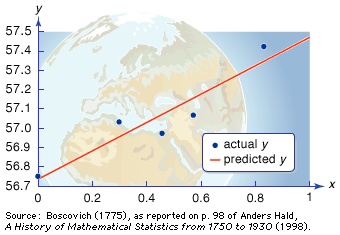least squares approximation
statistics
in statistics, a method for estimating the true value of some quantity based on a consideration of errors (error) in observations or measurements. In particular, the line (function) that minimizes the sum of the squared distances (deviations) from the line to each observation is used to approximate a relationship that is assumed to be linear. The method has also been generalized for use with nonlinear relationships.
One of the first applications of the method of least squares was to settle a controversy involving the shape of the Earth. The English mathematician Isaac Newton (Newton, Sir Isaac) asserted in the Principia (1687) that the Earth has an oblate (grapefruit) shape due to its spin—causing the equatorial diameter to exceed the polar diameter by about 1 part in 230. In 1718 the director of the Paris Observatory, Jacques Cassini (Cassini, Jacques), asserted on the basis of his own measurements that the Earth has a prolate (lemon) shape.
 To settle the dispute, in 1736 the French Academy of Sciences (Sciences, Academy of) sent surveying expeditions to Ecuador and Lapland. However, distances cannot be measured perfectly, and the measurement errors at the time were large enough to create substantial uncertainty. Several methods were proposed for fitting a line through this data—that is, to obtain the function (line) that best fit the data relating the measured arc length to the latitude. It was generally agreed that the method ought to minimize deviations in the y-direction (the arc length), but many options were available, including minimizing the largest such deviation and minimizing the sum of their absolute sizes (as depicted in the figure-->
To settle the dispute, in 1736 the French Academy of Sciences (Sciences, Academy of) sent surveying expeditions to Ecuador and Lapland. However, distances cannot be measured perfectly, and the measurement errors at the time were large enough to create substantial uncertainty. Several methods were proposed for fitting a line through this data—that is, to obtain the function (line) that best fit the data relating the measured arc length to the latitude. It was generally agreed that the method ought to minimize deviations in the y-direction (the arc length), but many options were available, including minimizing the largest such deviation and minimizing the sum of their absolute sizes (as depicted in the figure--> ). The measurements seemed to support Newton's theory, but the relatively large error estimates for the measurements left too much uncertainty for a definitive conclusion—although this was not immediately recognized. In fact, while Newton was essentially right, later observations showed that his prediction for excess equatorial diameter was about 30 percent too large.
). The measurements seemed to support Newton's theory, but the relatively large error estimates for the measurements left too much uncertainty for a definitive conclusion—although this was not immediately recognized. In fact, while Newton was essentially right, later observations showed that his prediction for excess equatorial diameter was about 30 percent too large.In 1805 the French mathematician Adrien-Marie Legendre (Legendre, Adrien-Marie) published the first known recommendation to use the line that minimizes the sum of the squares of these deviations—i.e., the modern least squares approximation. The German mathematician Carl Friedrich Gauss (Gauss, Carl Friedrich), who may have used the same method previously, contributed important computational and theoretical advances. The method of least squares is now widely used for fitting lines and curves to scatterplots (discrete sets of data).
- marbled pottery
- Marblehead
- Marbot, Jean-Baptiste-Antoine-Marcelin, baron de
- Marburg
- Marburg, Colloquy of
- Marburg, Philipps University of
- Marbury, Elisabeth
- Marbury v. Madison
- Marbut, Curtis Fletcher
- Marca
- Marcabru
- Marc Allégret
- Marc A. Mitscher
- Marc-Antoine Charpentier
- Marc-Antoine de Muret
- Marc-Antoine Girard Saint-Amant, sieur de
- Marc-Antoine Girard, sieur de Saint-Amant
- Marcantonio Franceschini
- Marcantonio Raimondi
- Marca-Relli, Conrad
- marcasite
- Marc Blitzstein
- Marc Bloch
- Marc Chagall
- Marc Connelly